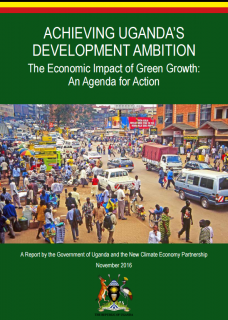This document, Achieving Uganda's Development Ambition - The Economic Impact of Green Growth: An agenda for action, analyzes the potential for green growth to support structural transformation in Uganda. It does so by identifying the most important constraints to development in Uganda, and then looks at how a range of green growth investments in the four sectors of agriculture, industry, energy, and cities can overcome these constraints relative to current trends.
Uganda has seen an average of 7% annual economic growth over the last two decades. This has resulted in a reduction in headcount poverty, from 56% in 1992-1993 to 20% in 2012-2013. Additionally, around half a million jobs have been created annually and access to basic services has improved. To build on this progress, Uganda will need to place an even greater emphasis on diversifying the economy and overcoming a number of constraints to development that could limit future prosperity for a growing, young, and increasingly urbanized population. This is critical as the country strives to reach upper middle-income status by 2040, realize the Sustainable Development Goals (SDG), and deliver on its international commitment to low-carbon economic growth as part of the Paris climate change agreement.
Uganda’s leaders understand that they will need to reconsider its growth model to deliver economic and social outcomes at the same time as protecting natural capital, managing the impacts of climate change, and using environmental policy to actually drive growth: a “green growth” model. This green growth model will require a continued focus on macroeconomic stability, improving the investment climate, and investing in health and education. It will also need to include an enhanced focus on improving the productivity of agriculture, developing high-value services and industry, providing access to modern energy, and harnessing the opportunities from urbanization. All are features of the development priorities outlined in the NDPII, and the President’s strategic priorities for 2016-2021.

